План урока living plants
Обновлено: 04.07.2024
Данный урок рекомендуется проводить на 1 курсе среди студентов, изучающих специальность 35.02.12 Садово-парковое и ландшафтное строительство.
| Вложение | Размер |
|---|---|
| konspekt.docx | 27.69 КБ |
| matveeva_olga.pptx | 685.98 КБ |
Предварительный просмотр:
Конспект урока английского языка на тему:
Данный урок рекомендуется проводить на 1 курсе среди студентов, изучающих специальность 35.02.12 Садово-парковое и ландшафтное строительство.
Ключевые слова: цветы (flowers), растения (plants), национальный символ (national symbol), букеты цветов (Flower Bouquets), листья (leaves).
- Linda Atwaroo-Ali. Biology for CSEC. Published by Macmillan, 2013 – 364 с.
Место в общей структуре курса:
Section B: Life processes. Reproduction in plants, стр. 209-220
образовательные: закрепить лексические единицы по теме
Развивающие: совершенствовать умения и навыки перевода стихов, развивать умения переводить (со словарем) иностранные тексты профессиональной направленности, умения общаться (устно и письменно) на английском языке на профессиональные и повседневные темы, умения использовать теоретические знания на практике, логически мыслить
Воспитывающие: воспитывать интерес к языку, способность самостоятельно выполнять задания и нести ответственность за результаты своего труда
- личностные: умение осознанно использовать речевые средства в соответствии с задачей коммуникации для выражения своих чувств, мыслей и потребностей; планирования и регуляции своей деятельности; владение устной и письменной речью, монологической контекстной речью.
- метапредметные: смысловое чтение; умение организовывать учебное сотрудничество и совместную деятельность с преподавателем и сверстниками; работать индивидуально и в группе: находить общее решение и разрешать конфликты на основе согласования позиций и учета интересов; формулировать, аргументировать и отстаивать свое мнение.
- предметные: достижение допорогового уровня иноязычной коммуникативной компетенции.
Методическое оснащение: наглядные пособия с изображениями растений и цветов, живые растения
Технические средства обучения: компьютеры, мультимедийный проектор
English teacher: Hello, students! Nice to see you! Today we will have a talk about “Plants and Flowers” and will repeat the tenses of the English verb. Can we live without plants and flowers? I think, no!
(Преподаватель приветствует студентов и сообщает им цель урока)
English teacher: First, I want you to answer my questions. Be active and give the full answers.
(Учащиеся отвечают на вопросы преподавателя по теме урока)
1) Do you have a favourite flower?
2) What kinds of flowers are popular in your country?
3) What is the national flower of England?
4) What is the symbol of peace?
5) What is the national symbol of Scotland?
6) What is the national symbol of Wales?
7) What is the national symbol of Northern Ireland?
8) When were two roses united into the Tudor rose?
9) What plant is a thistle?
10) Why did the Scots take the thistle as their national emblem?
11) Who is the patron saint of Wales?
12) What plant is a leek?
Who answered all questions? Kate? Well done! It’s great.
English teacher: You know a lot of plants and flowers in Russian! Let’s find out them in English!
Loot at the slide. There is new vocabulary. Max, read the words! Write down these words!
(Студенты знакомятся с лексикой, используя мультимедийную презентацию)
English teacher: Good for you! And now let’s read the following text! Nick, read, please!
Bright, vibrant flowers seem to be popular with people today. More modern flowers such as lilies are now being combined with old favourites like the Irish and Chrysanthemum. The tulip is another very popular flower. In Australia the tulip is in season from April until September or October.
Bright yellows, oranges and reds are often put together in baskets, bowls and bouquets. Green foliage such as Eucalyptus leaves is added to break up the color.
The most popular type of flower arrangement is the bouquet. They are hand-held and less expensive than arrangements in baskets and bowls. There can be a variety of flowers in a bouquet or just one type of flower.
Australians usually send flowers for special occasions, such as, the birth of a baby, weddings, birthdays, and funerals. Australia has a special day called “Daffodil Day” on the 1 st of September. On this day it is a tradition to buy a bunch of daffodils as a sign of respect for cancer sufferers. All proceeds from sales that day go towards cancer research
English teacher: Well done! Can you answer my questions?
- What is the most popular type of flower arrangement?
- What occasions do you usually present flowers?
- What colour of flowers do you put together in bouquets?
- Have you ever planted flowers?
- If you could create a bouquet of different flowers, which flowers would you choose?
- On which occasions do Australians give flowers?
- Do you have a special day like “Daffodil Day” in your country? If you could create such a day, to whom would you give the proceeds?
English teacher: Thank you very much for your answers! So, now do the following exercises to the text:
- Practise the pronunciation of the following words (слайд 4):
bouquet, popular, chrysanthemum, Australia, foliage, arrangement, eucalyptus, expensive, occasion, vibrant, bunch, tulip, iris, lily, daffodil
- Give Russian equivalents to the following words and word combinations from the text (слайд 5):
to seem, the lilies are now being combined with old favourites like the Irish and Chrysanthemum, to put together in baskets, bowls and bouquets, green foliage, to break up the color, the type of flower arrangement, hand-held, a variety of flowers, for special occasions, a special day, to buy a bunch of daffodils, a sign of respect.
- Find in text English equivalents to the following words and word combinations (слайд 6):
зеленая листва, быть популярным, самый популярный вид аранжировки цветов, сделанный руками, в букете, посылать цветы по особому случаю, в этот день, букет нарциссов, доходы от продажи
- Find in text synonyms to the following words and word combinations (слайд 7):
to mix, for special event, a token of respect, all returns, to break up the tint
- Find in the text antonyms to the following words and word combinations (слайд 8):
pale flowers, cheap, to sell, to take away the leaves, a sign of insult
- Fill in the blanks with suitable words from the active vocabulary (слайд 9):
1) I like to put together the beautiful flowers in … . 2) Yesterday my mother had her birthday. She got many bright and … flowers. 3) A … is a colourful flowers that is shaped like a cup. 4) A … is a large flower in the shape of a bell. 5) A … is a tall, usually purple, flower. 6) The leaves of a plant or tree are called … .7) A ceremony in which two people get married is called … .8) … is a tall yellow flower that grows in spring in our country. 9) She has worked hard to gain the … of her colleagues. 10) He died of lung …
(Студенты читают текст, отвечают на вопросы преподавателя и выполняют упражнения к тексту)
- Просмотр фильмов на английском языке, используя Интернет ресурсы
English teacher: Now you know a lot about plants, but it will be very interesting to watch two little documental films. In the first film Nicky Weitch talks about her first experiences of becoming a garden designer. In the second, you will watch photosynthesis at work.
English teacher: Please answer my questions!
- Why do you want to be a landscape designer?
- How did Nicky Weitch decide to arrange her garden?
- What is photosynthesis?
- What types of photosynthesis do you know?
- What is the main meaning of photosynthesis?
- Закрепление полученных знаний. Работа за компьютером. Повторение грамматического материала
Good for you, and now do the following exercises. Remember to use correct English tenses and the vocabulary about plant life.
1 . Translate into Russian paying attention to the Tenses of the English Verb:
1) When I saw Ann, she was sorting the flowers which she had picked in the field. 2) People are planting tulips now. 3) I have bought a bouquet of lilies for my mother today. 4) When I went out into the garden, the sun was shining and birds were singing in the trees. 5) They grew the vegetables. 6) I have planted a small apple tree in the garden. 7) My father has been planting lilies for two hours. 8) We have brought a lot of flowers from the wood. Now we will make bouquets.
2 . Translate the following sentences into English paying attention to the Tenses of the English Verb:
1) - Что ты делаешь? – Сажаю цветы. 2) Когда он пришел домой, цветы уже посадили. 3) Моя бабушка сажает цветы каждый день. 4) Она посадила цветы на прошлой неделе. 5) Ты уже посадила цветы? 6) Она сажает цветы уже 2 часа. 7) Когда я пришел домой, бабушка сажала цветы. 8) Я завтра посажу цветы.
- 1) Когда я увидел Аню, она сортировала цветы, которые собрала в поле. 2) Люди сажают тюльпаны сейчас. 3) Я сегодня купил букет лилий для моей мамы. 4) Когда я вышел в сад, солнце светило и птички пели на деревьях. 5) Они вырастили овощи. 6) Я посадил маленькую яблоню в саду. 77) Мой отец сажает лилии уже два часа. 8) Мы принесли цветы из леса. Теперь мы будем формировать букеты.
- 1) What are you doing? – I am planting flowers. 2) When he came home the flowers had been planted. 3) My granny plants flowers every day. 4) She planted flowers last week. 5) Have you planted flowers? 6) She has been planting flowers for two hours. 7) When I came home, my granny was planting flowers. 8) I will plant flowers tomorrow.
( Студенты, используя он-лайн сервис, решают кроссворд по теме, далее выполняют упражнения на повторение видовременных форм английского глагола)
- Подведение итогов урока, рефлексия, выставление оценок
Thank you for your work. Now it’s time to finish our work. What did you find out at this lesson? Why did we work with the subject “Plants and flowers” at this lesson? Your marks are…. . See you next week.
(Преподаватель подводит итоги урока, выставляет оценки, прощается со студентами, студенты проводят рефлексию урока)
Голицинский Ю. Грамматика: Сборник упражнений. – 6-е изд., - Спб.: КАРО, 2013. – 544 с.
Болотина А.Ю. Словарь лекарственных растений. – М.: АБИ Пресс, 2011. – 256 с.
Маккалистер Р. Самые неприхотливые комнатные растения: иллюстрированный справочник. – М.: Оникс, 2012. 127 с.
Предварительный просмотр:
Подписи к слайдам:
“Plants and Flowers ”
ACTIVE VOCABULARY bouquet [ ' bukeι ] n букет vibrant [ ' vaιbrәnt ] a ( зд .) броский , яркий lily [' lιlι ] n лилия iris [ ' aιәrιs ] n ирис chrysanthemum [ krι'sænθәmәm ] n хризантема tulip [ ' tju:lιp ] n тюльпан foliage [ ' foulιdζ ] n листва
bunch [ bΛnt ∫] n букет combine [ ' k כ mbaιn ] v 1) объединять( ся ) 2) комбинировать, сочетать( ся ),смешивать( ся ) bowl [ b ә ul ] n ваза для цветов eucalyptus [ ֽ ju : k ә' lιpt ә s ] n ( pl – ses [- sιz ], - ti ) эвкалипт arrangement [ә' reιndζm ә nt ] n расположение, аранжировка
1. Practise the pronunciation of the following words: bouquet, popular, chrysanthemum, Australia, foliage, arrangement, eucalyptus, expensive, occasion, vibrant, bunch, tulip, iris, lily, daffodil
2. Give Russian equivalents to the following words and word combinations from the text: to seem, the lilies are now being combined with old favourites like the Irish and Chrysanthemum, to put together in baskets, bowls and bouquets, green foliage, to break up the color, the type of flower arrangement, hand-held, a variety of flowers, for special occasions, a special day, to buy a bunch of daffodils, a sign of respect
3. Find in text English equivalents to the following words and word combinations: зеленая листва, быть популярным, самый популярный вид аранжировки цветов, сделанный руками, в букете, посылать цветы по особому случаю, в этот день, букет нарциссов, доходы от продажи
4. Find in text synonyms to the following words and word combinations: to mix, for special event, a token of respect, all returns, to break up the tint
5. Find in the text antonyms to the following words and word combinations: pale flowers, cheap, to sell, to take away the leaves, a sign of insult
6. Fill in the blanks with suitable words from the active vocabulary: 1) I like to put together the beautiful flowers in … . 2) Yesterday my mother had her birthday. She got many bright and … flowers. 3) A … is a colourful flowers that is shaped like a cup. 4) A … is a large flower in the shape of a bell. 5) A … is a tall, usually purple, flower. 6) The leaves of a plant or tree are called … .7) A ceremony in which two people get married is called … .8) … is a tall yellow flower that grows in spring in our country. 9) She has worked hard to gain the … of her colleagues. 10) He died of lung …
По теме: методические разработки, презентации и конспекты

План-конспект урока английского языка по теме "Цвета" для 2 класса
Урок разработан для учащихся 2 класса, либо для дошкольников. Остальные файлы - материалы обеспечения урока.


Конспект урока английского языка по теме: "Reading and discussing books" для учащихся 10 класса УМК "Английский в фокусе"
Конспект урока может быть использован в разделе темы: увлечения подростков в свободное время. Чтение книг. Тип урока: урок рефлексии в рамках системно - деятельностного подхода.
Конспект урока английского языка по теме"The Canterville Ghost". Учебник Ваулина Ю.Е. Английский в фокусе. [Текст] / Ваулина Ю.Е., Эванс В., Дули Дж. и др.: учебник для 7 класса общеобразовательных учреждений – М.: Express publishing: Просвещение, 2011.
Конспект урока английского языка по теме"The Canterville Ghost". Учебник Ваулина Ю.Е. Английский в фокусе. [Текст] / Ваулина Ю.Е., Эванс В., Дули Дж. и др.: учебник для 7 класса общеоб.
План - конспект урока английского языка по теме "People\'s abilities" в 6 классе по учебнику для учащихся общеобразовательных организаций "Forward" под редакцией М.В. Вербицкой на этапе введения в тему и усвоения новых знаний.

Конспект урока английского языка по теме "Значение иностранных языков в современном мире"
Данный конспект для урока английского языка по теме "Значение иностранных языков в современном мире" подойдёт для работы по учебнику 9 класса В.П.Кузовлева, Это будет качественной подд.

2 .Develop speaking and writing skills. Develop memory and attention.
3. To understand and love the nature;
Vis. Aims: an interactive board, a diagram, the pictures of plants and flowers.
Procedure of the lesson.
I. Organization moment.
II. Checking of home task. Ex. 8 . p 57
III. Warm up:
I like flowers that are bright
I like flowers that are white
I like flowers with a nice smell
That blossom [‘blosәm] in gardens so well
IV. Presentation.
Today we have a unusual lesson. Today we will speak about living plants, about flowers.
We’ll read the text, work with cards and do a lot of grammatical exercises.
- What kind of living plants do you know?
- Do you like living plants? Why?
First of all, look at the blackboard. Can you match the names to the pictures? Do you know the Kazakh names of the flowers in the pictures?
V. Reading. Ex 2, 4 p 59.
Talk to your partner.
- Do you like flowers?
- What’s your favourite flowers?
- Why is it your favourite flower?
- Do you like indoor plants?
VI. Work with an interactive board.
EX 3 p 60. Read the chart and complete it.
VII. Doing exercises
Ex 9 p 62. Match the translation of the English words.
a)3, b)1, c)4, d)2, e)5, f)6, g)7
Ex. 11 Read the text below and find the answers to the questions of ex. 10.
VIII. Writing
Complete the sentences
The rose grows……….. It grows in ………. Indoor plants …… the air our home.
Green indoor plants ……… pollutants.
IX. Dialogue
X. Work with cards
Theme: Living plants
Aims: 1 .To enrich pupils’ knowledge about living plants;
2 .Develop speaking and writing skills. Develop memory and attention.
3. To understand and love the nature;
Vis. Aims: an interactive board, a diagram, the pictures of plants and flowers.
Procedure of the lesson.
I. Organization moment.
II. Checking of home task. Ex. 8 . p 57
III. Warm up:
I like flowers that are bright
I like flowers that are white
I like flowers with a nice smell
That blossom [‘blosәm] in gardens so well
IV. Presentation.
Today we have a unusual lesson. Today we will speak about living plants, about flowers.
We’ll read the text, work with cards and do a lot of grammatical exercises.
- What kind of living plants do you know?
- Do you like living plants? Why?
First of all, look at the blackboard. Can you match the names to the pictures? Do you know the Kazakh names of the flowers in the pictures?
V. Reading. Ex 2, 4 p 59.
Talk to your partner.
- Do you like flowers?
- What’s your favourite flowers?
- Why is it your favourite flower?
- Do you like indoor plants?
VI. Work with an interactive board.
EX 3 p 60. Read the chart and complete it.
VII. Doing exercises
Ex 9 p 62. Match the translation of the English words.
a)3, b)1, c)4, d)2, e)5, f)6, g)7
Ex. 11 Read the text below and find the answers to the questions of ex. 10.
VIII. Writing
Complete the sentences
The rose grows……….. It grows in ………. Indoor plants …… the air our home.
Green indoor plants ……… pollutants.
IX. Dialogue
X. Work with cards
Translate into Kazakh
Read the sentences
The rose grows in the gardens. It grows in spring and summer.
Write missing letters
XI. Conclusion
- Do you have plants at home? * Do you have indoor plants?
- Do you know that green leaves are very beneficial to your health?
- Do you know that living plants can actually improve the air we breathe?
VI. Home task
Ex.17 . Read Aigerim’s story and write a story about flowers at your school
Свидетельство и скидка на обучение каждому участнику
Зарегистрироваться 15–17 марта 2022 г.
Theme: Living plants
1) to describe and compare plants, present new words connected with the theme, to revise the Present Simple tense.
2) to enlarge the pupils` vocabulary, to develop speaking, grammar skills.
3) to develop the pupils` logical thinking, to teach to take care of the environment.
Visual aids: cards (plural of nouns), pictures (plants)
Methods: group wok
Process of the lesson:
Greeting: Good afternoon, dear children. How are you?
Who is absent today? What day is it today? What is the weather like today?
Are you ready for the lesson?
Warming-up: I have two eyes and I can see,
I have two ears and I can hear.
I have a mouth and I can talk,
I have two legs and I can walk.
Checking-up the home work.
New words: height, trunk, cactus, hug, spine, birch, grow, weigh, brunch.
Poster about tree.
Main part. Brainstorming: What kinds of animals do you know?
What kinds of trees do you know?
Let`s do a crossword. The key word is flowers . Today we have a new theme about flowers. Look at the pictures and match them with their names.
Presentation 1. Plural of nouns
A potato – potatoes
Working with cards: grammar exercise
New words: snowdrops, dandelion , rose, daisy, birch, smell, to smell.
Read the text and have a guessing game.
Read the chart and complete it.
Interview your partner.
Writing. Exercise 8.
Discussion. Are indoor plants useful to our health?
Home work. Ex.11 p.179.
- подготовка к ЕГЭ/ОГЭ и ВПР
- по всем предметам 1-11 классов
Курс повышения квалификации
Дистанционное обучение как современный формат преподавания

Курс повышения квалификации
Инструменты онлайн-обучения на примере программ Zoom, Skype, Microsoft Teams, Bandicam
- Курс добавлен 31.01.2022
- Сейчас обучается 30 человек из 19 регионов

Курс повышения квалификации
Специфика преподавания английского языка с учетом требований ФГОС
- Для учеников 1-11 классов и дошкольников
- Бесплатные сертификаты учителям и участникам
Дистанционные курсы для педагогов
Найдите материал к любому уроку, указав свой предмет (категорию), класс, учебник и тему:
5 613 185 материалов в базе
- ЗП до 91 000 руб.
- Гибкий график
- Удаленная работа
Самые массовые международные дистанционные
Школьные Инфоконкурсы 2022
Свидетельство и скидка на обучение каждому участнику
Другие материалы
Вам будут интересны эти курсы:
Оставьте свой комментарий
- 08.04.2016 1956
- DOCX 16 кбайт
- 1 скачивание
- Оцените материал:
Настоящий материал опубликован пользователем Хаметова Асель Куанышбековна. Инфоурок является информационным посредником и предоставляет пользователям возможность размещать на сайте методические материалы. Всю ответственность за опубликованные материалы, содержащиеся в них сведения, а также за соблюдение авторских прав несут пользователи, загрузившие материал на сайт
Если Вы считаете, что материал нарушает авторские права либо по каким-то другим причинам должен быть удален с сайта, Вы можете оставить жалобу на материал.
Автор материала
40%
- Подготовка к ЕГЭ/ОГЭ и ВПР
- Для учеников 1-11 классов
Московский институт профессиональной
переподготовки и повышения
квалификации педагогов
Дистанционные курсы
для педагогов
663 курса от 690 рублей
Выбрать курс со скидкой
Выдаём документы
установленного образца!
Учителя о ЕГЭ: секреты успешной подготовки
Время чтения: 11 минут
Рособрнадзор предложил дать возможность детям из ДНР и ЛНР поступать в вузы без сдачи ЕГЭ
Время чтения: 1 минута
Новые курсы: преподавание блогинга и архитектуры, подготовка аспирантов и другие
Время чтения: 16 минут
Отчисленные за рубежом студенты смогут бесплатно учиться в России
Время чтения: 1 минута
В Россию приехали 10 тысяч детей из Луганской и Донецкой Народных республик
Время чтения: 2 минуты
Время чтения: 2 минуты
В Госдуме предложили ввести сертификаты на отдых детей от 8 до 17 лет
Время чтения: 1 минута
Подарочные сертификаты
Ответственность за разрешение любых спорных моментов, касающихся самих материалов и их содержания, берут на себя пользователи, разместившие материал на сайте. Однако администрация сайта готова оказать всяческую поддержку в решении любых вопросов, связанных с работой и содержанием сайта. Если Вы заметили, что на данном сайте незаконно используются материалы, сообщите об этом администрации сайта через форму обратной связи.
Все материалы, размещенные на сайте, созданы авторами сайта либо размещены пользователями сайта и представлены на сайте исключительно для ознакомления. Авторские права на материалы принадлежат их законным авторам. Частичное или полное копирование материалов сайта без письменного разрешения администрации сайта запрещено! Мнение администрации может не совпадать с точкой зрения авторов.

урок презентация показ слайдов тема урока Living plants слайд состоит из 17 слайдов метод урока интеракттивный тип урока новый урок, работа в парах, составление мини расказов про цветы и растения цели урока развить умение работать в парах в группах привить любовь к цветам
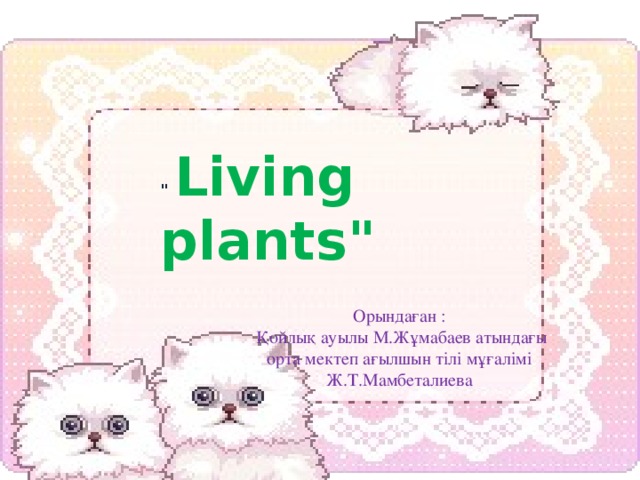
" Living plants "
Қойлық ауылы М.Жұмабаев атындағы орта мектеп ағылшын тілі мұғалімі Ж.Т.Мамбеталиева

Translate from English into Kazakh
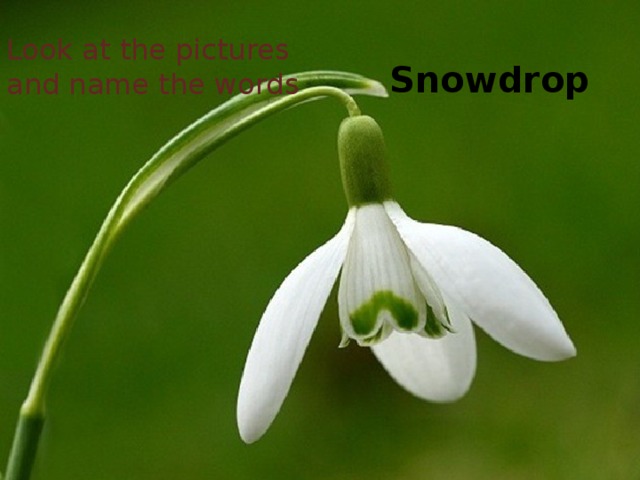
Look at the pictures and name the words

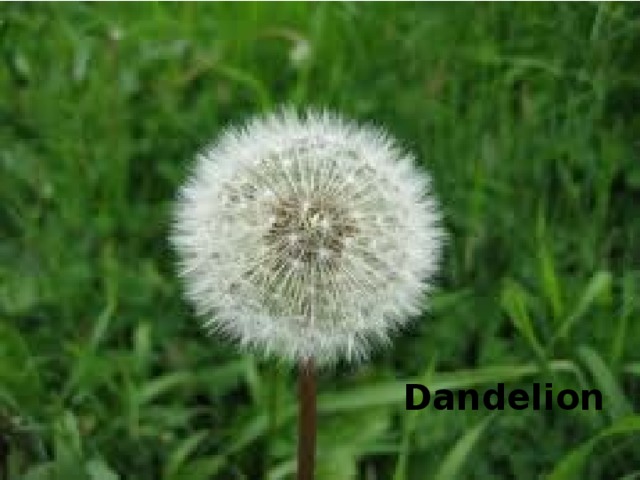
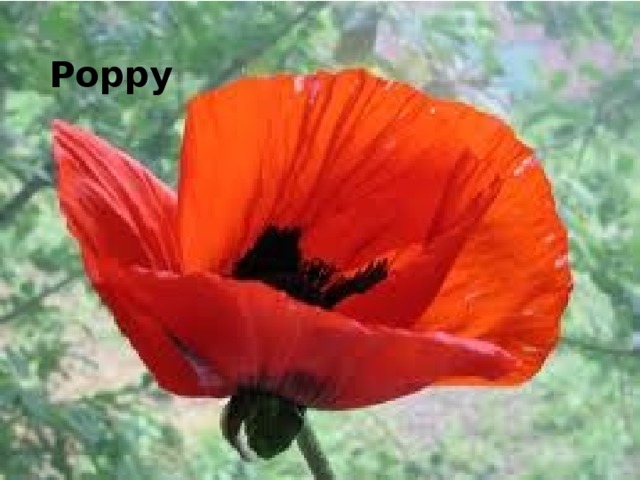
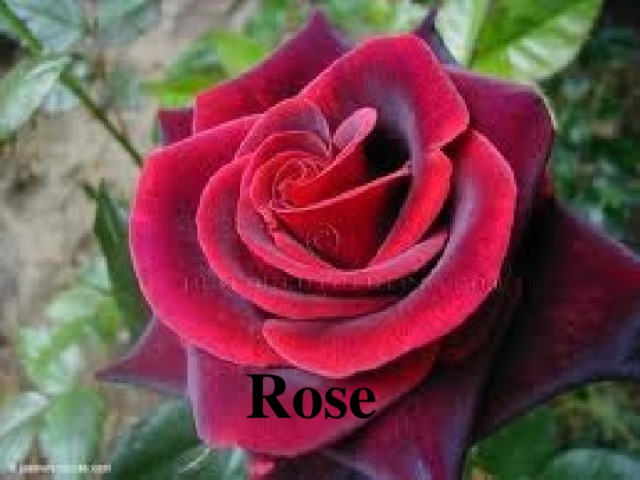
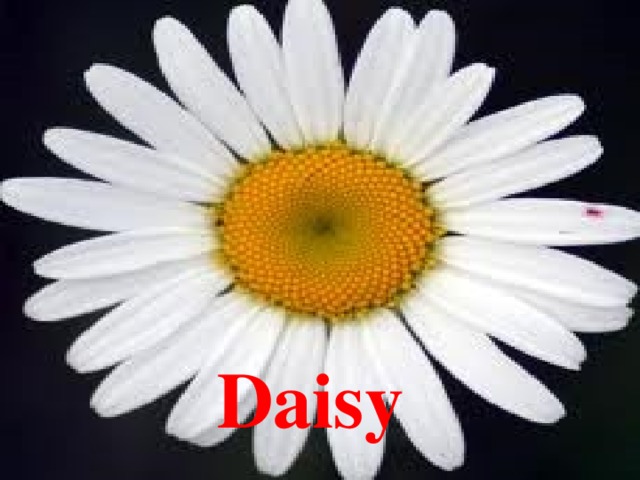
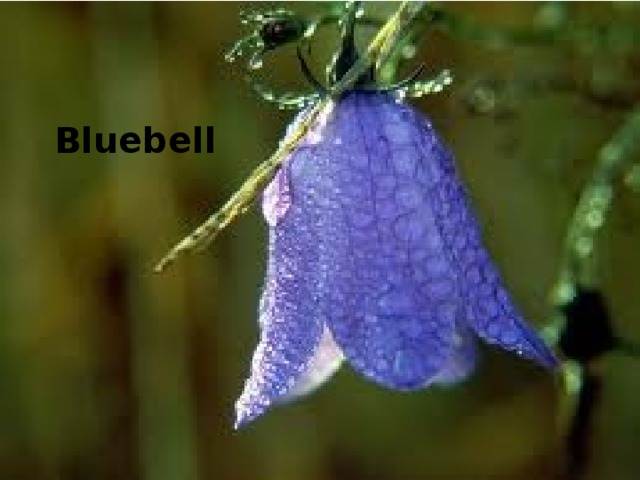
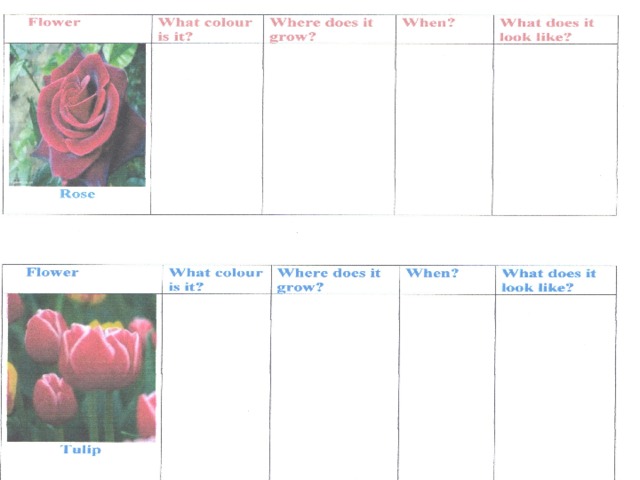
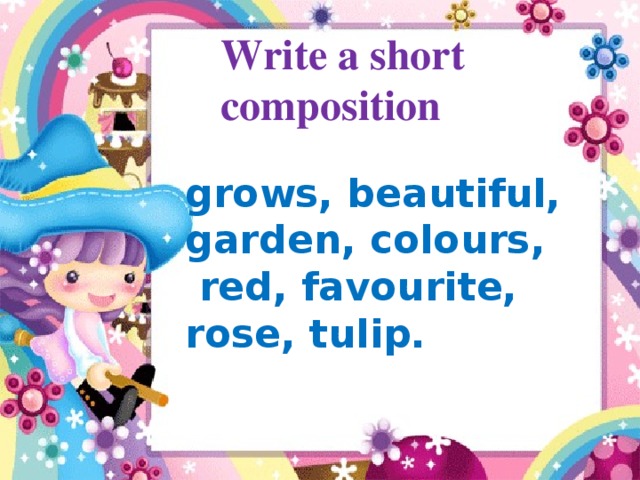
Write a short
composition
grows, beautiful, garden, colours,
red, favourite, rose, tulip.
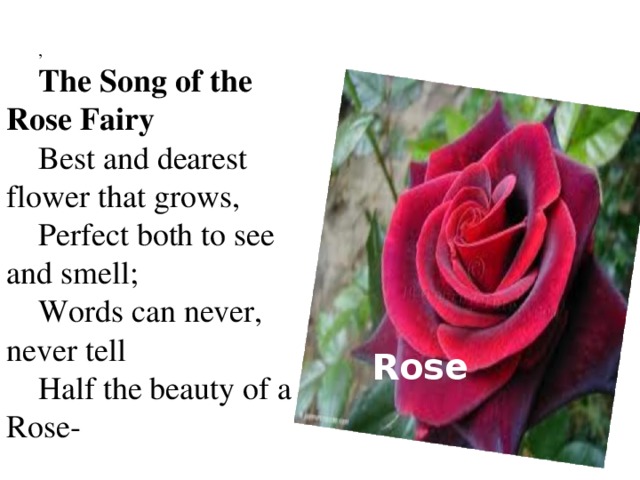
The Song of the Rose Fairy
Best and dearest flower that grows,
Perfect both to see and smell;
Words can never, never tell
Half the beauty of a Rose-
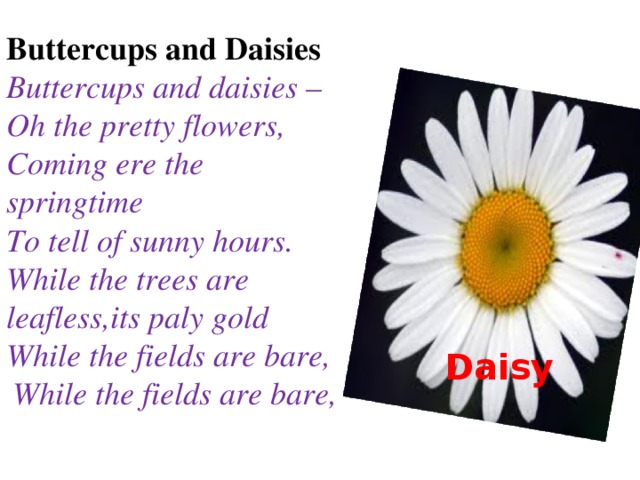
Buttercups and Daisies
Buttercups and daisies –
Oh the pretty flowers,
Coming ere the springtime
To tell of sunny hours.
While the trees are leafless,its paly gold
While the fields are bare,
While the fields are bare,
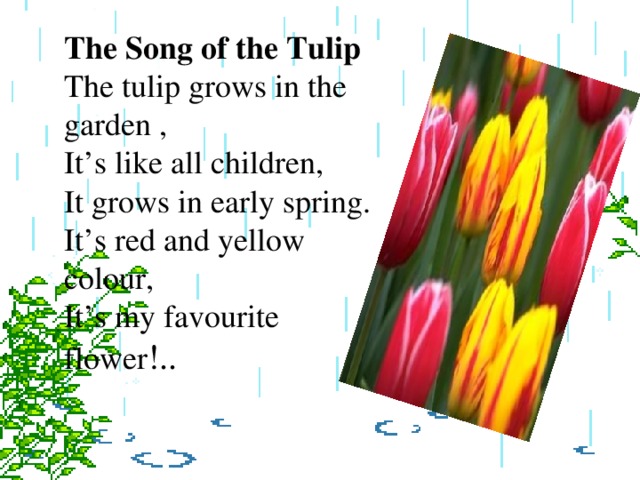
The Song of the Tulip
The tulip grows in the garden ,
It’s like all children,
It grows in early spring.
It’s red and yellow colour,
It’s my favourite flower .
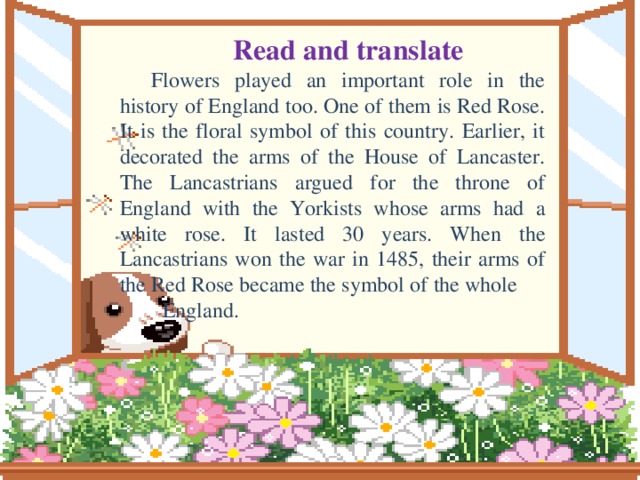
Read and translate
Flowers played an important role in the history of England too. One of them is Red Rose. It is the floral symbol of this country. Earlier, it decorated the arms of the House of Lancaster. The Lancastrians argued for the throne of England with the Yorkists whose arms had a white rose. It lasted 30 years. When the Lancastrians won the war in 1485, their arms of the Red Rose became the symbol of the whole England.
Morning glory
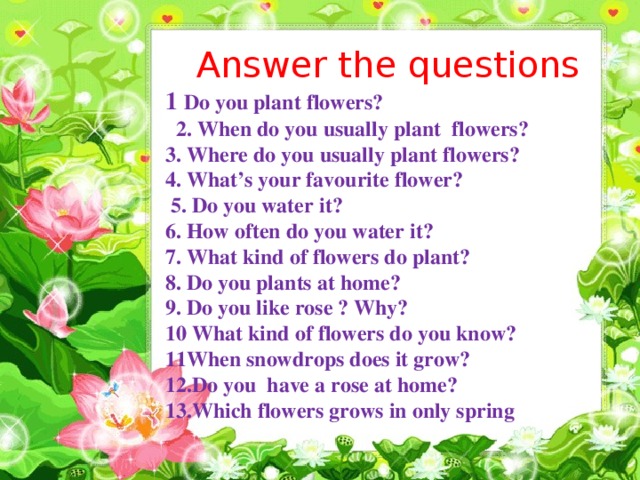
Answer the questions
1 Do you plant flowers?
2. When do you usually plant flowers?
3. Where do you usually plant flowers?
4. What’s your favourite flower?
5. Do you water it?
6. How often do you water it?
7. What kind of flowers do plant?
8. Do you plants at home?
9. Do you like rose ? Why?
10 What kind of flowers do you know?
11When snowdrops does it grow?
12.Do you have a rose at home?
13.Which flowers grows in only spring
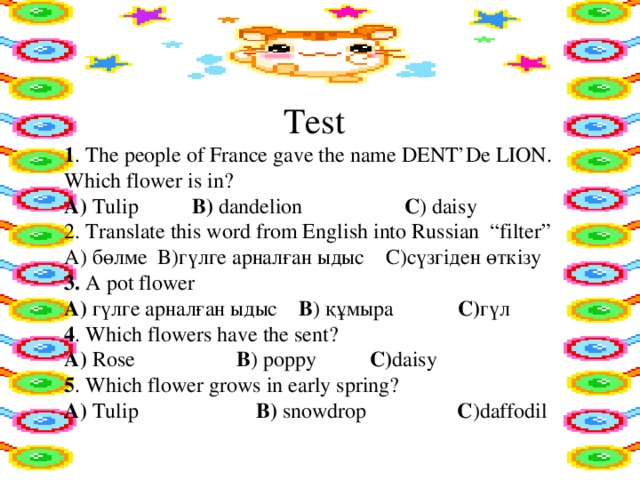
1 . The people of France gave the name DENT’De LION. Which flower is in?
The living world.
The living plants.
1) Обеспечить в ходе урока усвоение учащимися лексики по данной теме.
2) Содействовать формированию бережного отношения к окружающему миру.
3) Развивать навыки чтения и говорения.
To benefit, to improve, to filter, beneficial, indoor plant, to prevent.
The procedure of the lesson:
T: Good morning, dear children! Sit down! Who is on duty today? What date is it today? Who is absent today?
What day is it today? What’s the weather like today?
Do you like plants and trees? What flowers do you know? Do you have any flowers at home?
Ex. 8 p. 62 Give me your copybooks!
Today we are going to continue talking about flowers.
Ex. 9 p. 62 Make matches. Open your vocabularies and write down the new words. Repeat after me in chorus!
Читайте также:

